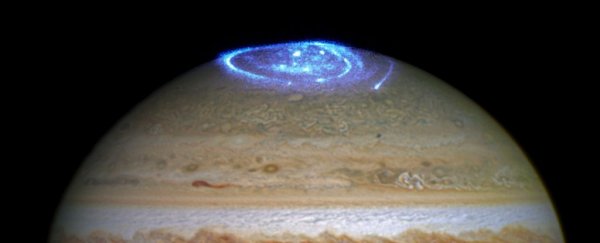Jupiter has finally been observed spitting out X-rays in high-energy wavelengths.
Emanating from the giant planet's permanent auroras, and detected by NASA's space-based X-ray telescope NuSTAR, the emissions are the most energetic light seen coming from any planet in the Solar System (aside from Earth).
The detection could shed light on the most powerful auroras in the Solar System, and solves a longstanding mystery: why the joint ESA-NASA Ulysses spacecraft didn't detect any Jovian X-rays in its nearly three decades of operation between 1990 and 2009.
Jupiter's auroras constitute an absolutely fascinating phenomenon. At both its poles, the planet is ringed by permanent auroras – invisible to our eyes, but glowing brilliantly in ultraviolet wavelengths. These regions have also been observed emitting low-energy, or 'soft' X-rays, by X-ray observatories Chandra and XMM-Newton.
Scientists thought that there should also be high-energy, or 'hard' X-rays X-rays, beyond what those instruments can detect. So they used NuSTAR to look for them.
"It's quite challenging for planets to generate X-rays in the range that NuSTAR detects," said astrophysicist Kaya Mori of Columbia University.
"But Jupiter has an enormous magnetic field, and it's spinning very quickly. Those two characteristics mean that the planet's magnetosphere acts like a giant particle accelerator, and that's what makes these higher-energy emissions possible."
Jupiter's auroras are both like and unlike auroras here on Earth, where they are generated by particles blowing in from the Sun. They collide with Earth's magnetic field, which sends charged particles like protons and electrons whizzing along the magnetic field lines towards the poles, where they rain down on Earth's upper atmosphere and collide with atmospheric molecules. The resulting ionization of these molecules generates the stunning dancing lights.
On Jupiter, the basic mechanism is similar, but there are a few differences. The auroras are constant and permanent, as previously noted; that's because the particles are not solar, but from the Jovian moon Io, the most volcanic world in the Solar System.
It's constantly belching out sulfur dioxide, which is immediately stripped via a complex gravitational interaction with the planet, becoming ionized and forming a plasma torus around the gas giant. Particles from this torus get sent whizzing along magnetic field lines to the poles, and so on.
 The emission detected by NuSTAR. (NASA/JPL-Caltech)
The emission detected by NuSTAR. (NASA/JPL-Caltech)
This process generates soft X-rays, as previously discovered. Now, hard X-rays have been found too. It wasn't an easy detection to make, since the high-energy X-rays are actually quite faint, but that, the researchers said, doesn't explain why Ulysses couldn't detect them. The answer, they found, lies in the way the hard X-rays are generated.
When electrons are accelerated along Jupiter's magnetic field lines, they end up entering the planet's atmosphere at high speed. When these electrons enter the vicinity of atomic nuclei, and their electric fields, they are abruptly deflected and decelerated. However, their kinetic energy has to go somewhere, according to the law of the conservation of energy, so it gets converted into X-radiation.
This is called bremsstrahlung, or braking radiation. The soft X-rays are generated via a different mechanism called charge exchange, in which electrons are transferred to ions, the excitement of which generates a glow.
These mechanisms each produce a different light profile, the researchers said. At higher energies, bremsstrahlung X-rays should be fainter at higher energies, which would explain why Ulysses never found them.
The team modeled the data including the bremsstrahlung mechanism, and not only did it match the NuSTAR observations, it showed that the emission is outside Ulysses' sensitivity range. So far so good, but we've only just begun to probe the phenomenon.
For example, while NuSTAR could detect hard X-rays in the general region of the Jovian auroras, it was unable to pinpoint a precise emission point.
"The discovery of these emissions does not close the case; it's opening a new chapter," said astronomer William Dunn of the University College London in the UK.
"We still have so many questions about these emissions and their sources. We know that rotating magnetic fields can accelerate particles, but we don't fully understand how they reach such high speeds at Jupiter. What fundamental processes naturally produce such energetic particles?"
Future hard X-ray studies of Jupiter's auroras could help shed more light on the physics at play.
The research has been published in Nature Astronomy.
